Transurban Group Bundle
Can Transurban Group Continue to Thrive in the Evolving Transportation Landscape?
Transurban Group, a leader in toll road infrastructure, has become a cornerstone of urban mobility since its inception in 1996. With a current market capitalization of approximately $28.9 billion as of June 3, 2025, the company's Transurban Group SWOT Analysis reveals its strategic positioning in a world increasingly reliant on efficient transportation networks. Its growth strategy is crucial, given the rising demand for infrastructure investment and the challenges of inflation and financing.
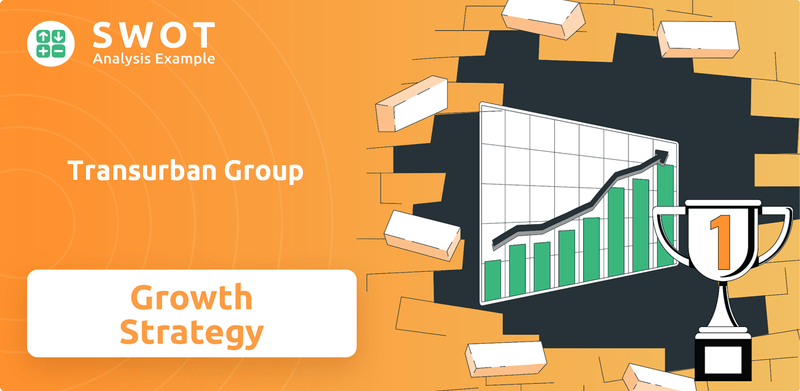
This analysis explores the future prospects of Transurban Group, examining its expansion plans across Australia, the United States, and Canada. We'll delve into how Transurban Group is leveraging technology, managing its finances, and navigating potential risks to maintain its competitive edge in the toll roads sector. Understanding the company's long-term growth strategy is key to evaluating its potential for investors and stakeholders alike, considering factors such as its impact on traffic congestion and its commitment to sustainable infrastructure initiatives.
How Is Transurban Group Expanding Its Reach?
The expansion strategy of Transurban Group is primarily focused on strengthening its position in existing markets while also exploring new avenues for growth. This approach involves significant capital expenditure and the use of public-private partnerships (PPPs) to fund and develop infrastructure projects. These initiatives aim to improve urban mobility and reduce congestion, thereby enhancing the company's revenue streams and market presence.
A key element of Transurban's growth strategy is the continuous investment in road infrastructure. The company is actively involved in road extensions, upgrades, and widenings across its markets. These projects are designed to accommodate increasing traffic volumes and improve the overall transportation experience for users. The company's focus on sustainable infrastructure initiatives also plays a crucial role in its long-term growth strategy.
The company is actively pursuing over $12.0 billion in road extensions, upgrades, and widenings in its Australian markets. This includes projects like the Logan Motorway widening, which are expected to drive future traffic growth. In North America, Transurban is exploring PPP opportunities in the U.S. and Canada, which offer ongoing optionality. These investments are crucial for the company's future prospects.
Several major projects are currently underway. The West Gate Tunnel Project in Melbourne is approximately 85% complete and is scheduled to open in 2025. In North America, the 495 Northern Extension is about 65% complete and is also expected to open in 2025. These projects represent significant infrastructure investment.
The Opitz Boulevard project, part of the 95 Express Lane Enhancements, opened in November 2024. This project provides additional connections and improves traffic flow. These new additions are part of the company's commitment to enhancing urban mobility.
Transurban is also considering expansion into new markets to diversify its revenue streams. New Zealand is being explored as a potential market in 2025. This strategic move aims to access new customers and stay ahead of industry changes, ensuring long-term growth.
Transurban leverages technology to improve connectivity and reduce congestion. This includes smart tolling systems and traffic management solutions. These technological advancements are crucial for the company's operational efficiency and customer experience. The company's use of technology is a key aspect of its strategy.
Transurban's expansion initiatives are driven by several strategic objectives. These include increasing the company's market share, enhancing operational efficiency, and delivering value to shareholders. The company's focus on infrastructure investment supports these goals.
- Deepening presence in existing markets through strategic projects.
- Exploring new market opportunities, such as New Zealand, to diversify revenue.
- Leveraging PPPs to fund large-scale infrastructure projects.
- Focusing on technological advancements to improve traffic management.
For a deeper understanding of the company's origins and evolution, you can refer to the Brief History of Transurban Group. The company's expansion plans are a testament to its commitment to sustainable infrastructure and its long-term growth strategy.
Transurban Group SWOT Analysis
- Complete SWOT Breakdown
- Fully Customizable
- Editable in Excel & Word
- Professional Formatting
- Investor-Ready Format
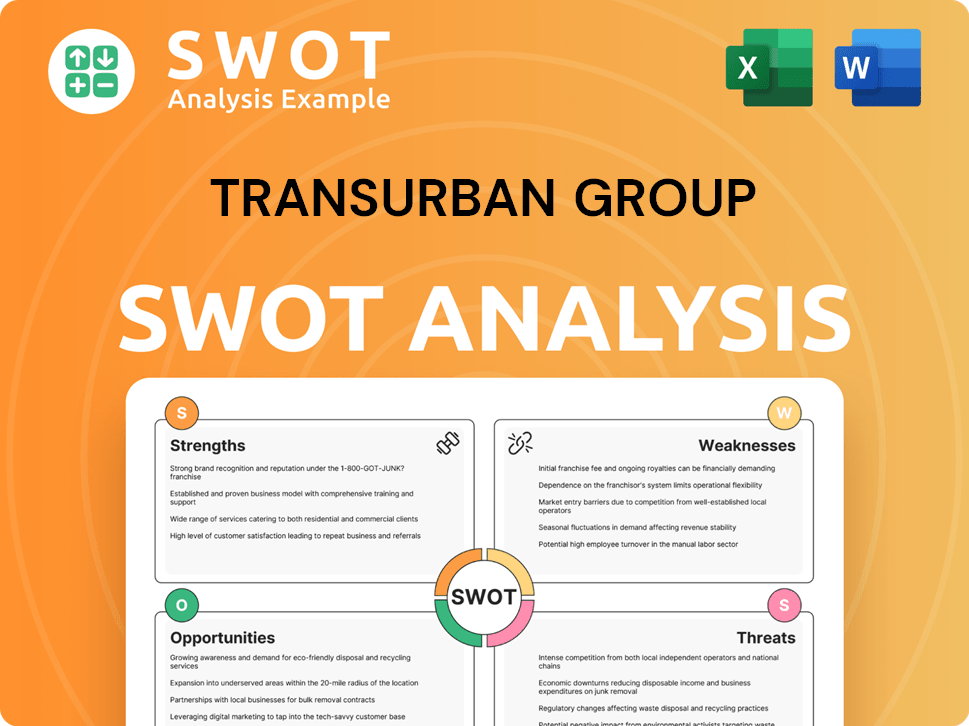
How Does Transurban Group Invest in Innovation?
The Transurban Group focuses on leveraging technology and innovation to improve its operations and enhance customer experiences, which is crucial for its growth strategy and future sustainability. Their approach includes significant investments in research, analysis, and real-world testing of connected technologies, advanced driver assistance systems, and automated vehicles, particularly in the freight sector. This strategy aims to solidify their position as a leader in facilitating smoother and safer urban mobility.
The company's dedication to technological advancement is evident in its digital transformation initiatives. These efforts are designed to improve efficiency, provide better customer service, and support sustainable practices. By integrating innovative solutions, Transurban Group aims to meet the evolving needs of commuters and the broader community.
One of the key aspects of Transurban's digital transformation is the implementation of a generative AI chatbot, launched in August 2024. This chatbot has managed approximately 62% of over 280,000 customer inquiries without requiring human intervention. The Linkt app has also been enhanced to provide estimated travel time savings across all Australian markets, a feature rolled out between October 2024 and February 2025. Furthermore, a new billing system has been introduced to offer a more personalized customer experience, and the Linkt Rewards program has expanded to include eight reward partners by 2025, growing sixfold since FY23 to approximately 1.4 million customers.
In terms of environmental sustainability, Transurban Group is committed to transitioning its fleet to zero-emissions vehicles and increasing its use of renewable energy. Since January 2022, over 60% of the company's operations have been powered by renewable energy, with further increases expected by 2024 through renewable power purchasing agreements. This commitment aligns with the company's broader environmental goals and contributes to its long-term growth strategy.
- The company is actively incorporating plug-in hybrid electric vehicles into its fleet.
- Plans are in place to increase the number of electric vehicles by 2025.
- These initiatives support the company's commitment to sustainable infrastructure.
- These measures are part of the company's broader environmental sustainability report.
Transurban Group PESTLE Analysis
- Covers All 6 PESTLE Categories
- No Research Needed – Save Hours of Work
- Built by Experts, Trusted by Consultants
- Instant Download, Ready to Use
- 100% Editable, Fully Customizable
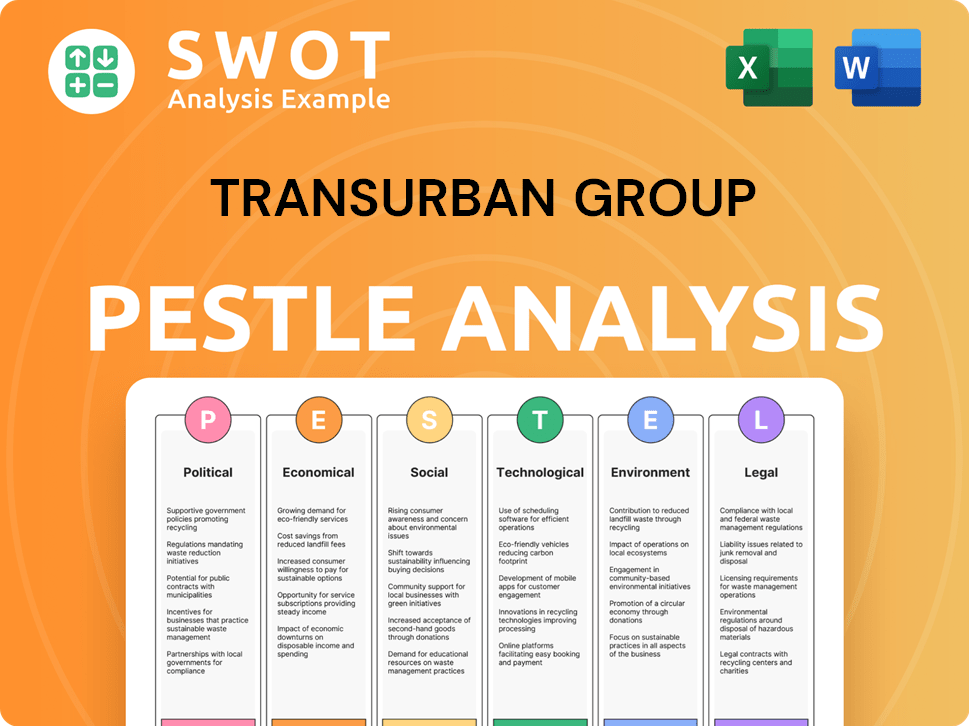
What Is Transurban Group’s Growth Forecast?
The financial outlook for Transurban Group indicates strong and consistent Growth Strategy, with key financial metrics showing positive trends into 2025. The company's strategic focus on Infrastructure Investment and its established position in the Toll Roads sector support this optimistic view. This analysis provides a detailed look at the financial projections, including revenue, earnings, and dividends, offering insights into the company's potential for future expansion and performance.
Transurban Group's financial health appears robust, underpinned by a strategic approach to managing its debt and investments. The company's ability to secure significant debt funding in FY24 demonstrates its capacity to support project delivery and maintain its growth trajectory. The following financial data highlights the company's performance and future expectations, providing a comprehensive view of its financial position.
The company's financial performance is crucial for understanding its Future Prospects. The following data reveals key financial indicators and projections, offering a clear picture of Transurban Group's financial health and growth potential. The figures highlight the company's ability to generate revenue, manage costs, and return value to shareholders, which are essential for assessing its long-term viability and investment attractiveness. For more insights into the company's mission and values, you can read about it here: Mission, Vision & Core Values of Transurban Group.
Transurban Group's proportional revenue increased to $3.535 billion in 2024 from $3.314 billion in 2023. The company anticipates further growth, with projections to reach $3.765 billion in 2025. This growth is driven by new road infrastructure, increased traffic, and toll price adjustments, reflecting the company's strategic initiatives.
Earnings before interest, tax, depreciation, and amortisation (EBITDA) rose from $2.448 billion in 2023 to $2.631 billion in 2024. Further growth is expected, with a forecast of $2.842 billion in 2025. This increase underscores the company's operational efficiency and its ability to generate strong cash flows.
Adjusted earnings per share (EPS) improved from $0.63 in 2023 to $0.73 in 2024. The company projects EPS to reach $0.78 in 2025. This indicates an improvement in profitability and the company's ability to deliver value to shareholders.
Dividends are also expected to increase, from $0.58 per share in 2023 to $0.62 in 2024, with a forecast of $0.65 in 2025. This reflects the company's commitment to returning value to shareholders and its confidence in its financial performance.
The company's financial health is supported by its proportional gearing ratio of 38% as of December 2024. The net debt to EBITDA is forecast to decrease from 9 times in fiscal 2024 to below 7 times in the coming years. The fair value estimate is AUD 13 per security, implying a fiscal 2025 enterprise value/adjusted EBITDA of 21 times and a yield of 5%.
- 5% average revenue growth is expected over the next five years.
- $5 billion of debt was raised in FY24 to support funding initiatives.
- An interim distribution of 32.0 cents per stapled security was announced for the six months ending December 2024.
- A Distribution Reinvestment Plan is in place.
Transurban Group Business Model Canvas
- Complete 9-Block Business Model Canvas
- Effortlessly Communicate Your Business Strategy
- Investor-Ready BMC Format
- 100% Editable and Customizable
- Clear and Structured Layout
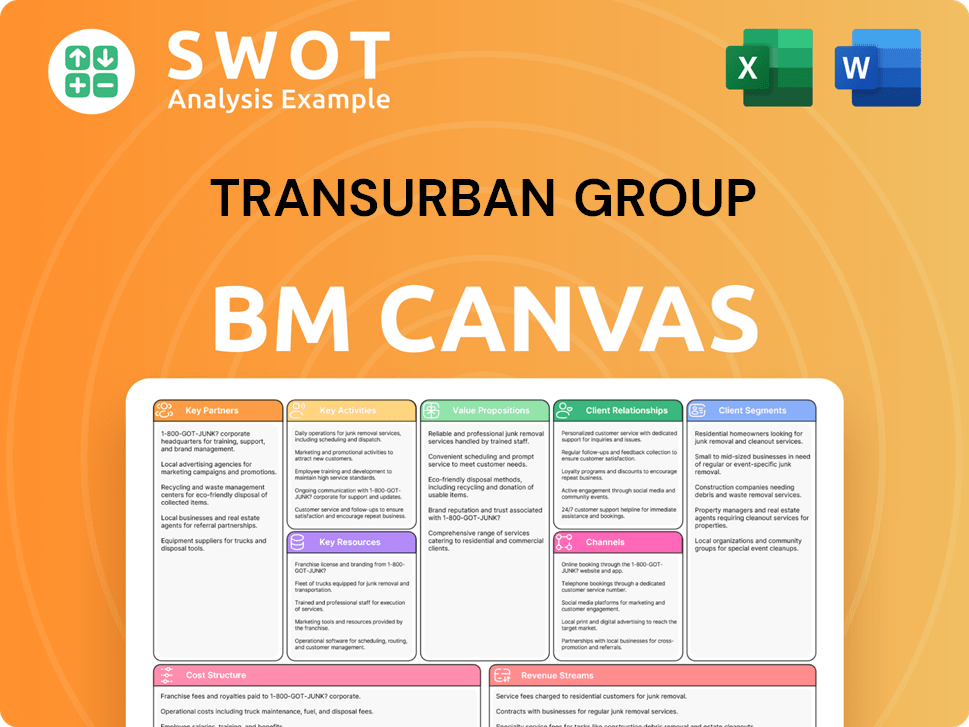
What Risks Could Slow Transurban Group’s Growth?
The Transurban Group faces several risks that could affect its Growth Strategy and Future Prospects. These challenges include market competition, regulatory changes, and the capital-intensive nature of toll road projects. The company's financial health and operational efficiency are also subject to external factors such as economic downturns and interest rate fluctuations, which can impact borrowing costs and traffic volumes.
Operational risks, including project delays and escalating costs, further complicate Transurban Group's expansion plans. The company must navigate these hurdles while managing its balance sheet and adapting to evolving market conditions. Additionally, the company's dividend policy and climate-related risks present further considerations.
The company's performance in the March 2025 quarter shows a mixed picture, with average daily traffic (ADT) up 1.8% year-on-year, but a net loss of AU$0.015 per share in the first half of fiscal 2025. This loss was attributed to rising operational costs, weather-related disruptions, and infrastructure maintenance and expansion expenses. Net margins also collapsed to 2% from 5.3% a year ago.
Although Transurban Group benefits from a wide economic moat, new entrants and existing competitors pose a challenge. The competitive landscape for toll roads and infrastructure investment is dynamic. Understanding the Competitors Landscape of Transurban Group is crucial for strategic planning.
Regulatory changes, particularly concerning toll increases, can affect revenue. The company is currently in negotiations with the NSW government regarding toll reform. These negotiations could significantly impact the company's financial outcomes.
Weak economic conditions or future lockdowns could depress traffic and toll increases. Economic volatility can affect Urban Mobility and the demand for toll road services. These factors directly influence the company's revenue streams.
Toll roads are capital-intensive, requiring ongoing access to debt markets. Deterioration of credit markets could increase borrowing costs. This can strain the company's financial resources, especially during economic downturns.
Rising interest rates can increase borrowing costs, affecting profitability. Interest rate fluctuations directly influence the financial burden associated with infrastructure projects. Changes in interest rates can affect the company's financial performance.
Climate-related risks are being integrated into forward planning from FY25. These risks can impact maintenance expenses and operational efficiency. Managing climate-related impacts is crucial for long-term sustainability.
Transurban Group Porter's Five Forces Analysis
- Covers All 5 Competitive Forces in Detail
- Structured for Consultants, Students, and Founders
- 100% Editable in Microsoft Word & Excel
- Instant Digital Download – Use Immediately
- Compatible with Mac & PC – Fully Unlocked
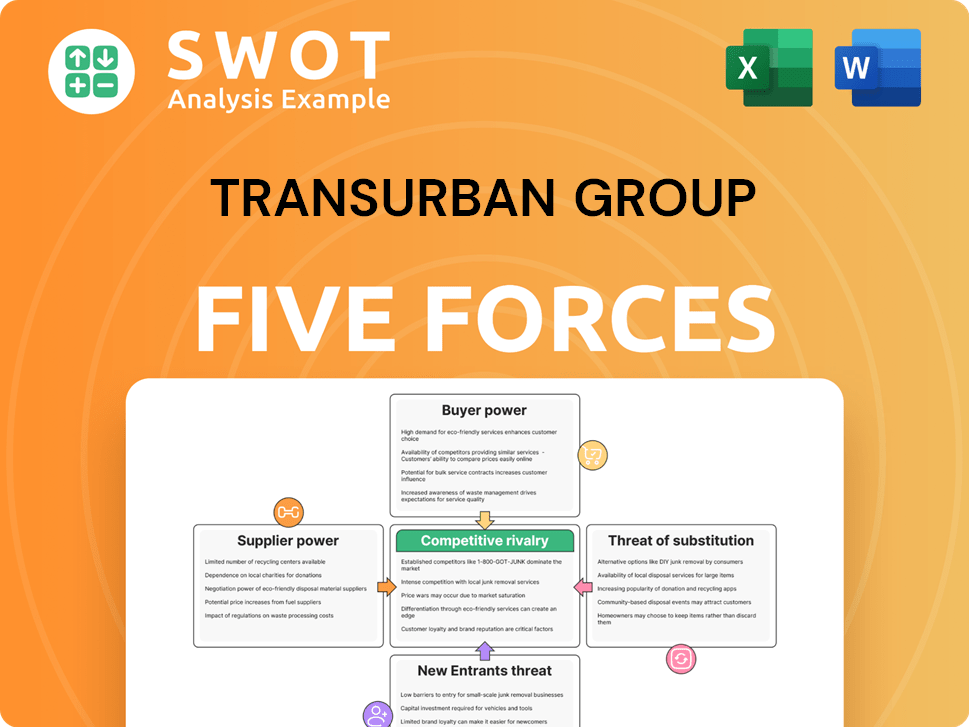
Related Blogs
- What are Mission Vision & Core Values of Transurban Group Company?
- What is Competitive Landscape of Transurban Group Company?
- How Does Transurban Group Company Work?
- What is Sales and Marketing Strategy of Transurban Group Company?
- What is Brief History of Transurban Group Company?
- Who Owns Transurban Group Company?
- What is Customer Demographics and Target Market of Transurban Group Company?
Disclaimer
All information, articles, and product details provided on this website are for general informational and educational purposes only. We do not claim any ownership over, nor do we intend to infringe upon, any trademarks, copyrights, logos, brand names, or other intellectual property mentioned or depicted on this site. Such intellectual property remains the property of its respective owners, and any references here are made solely for identification or informational purposes, without implying any affiliation, endorsement, or partnership.
We make no representations or warranties, express or implied, regarding the accuracy, completeness, or suitability of any content or products presented. Nothing on this website should be construed as legal, tax, investment, financial, medical, or other professional advice. In addition, no part of this site—including articles or product references—constitutes a solicitation, recommendation, endorsement, advertisement, or offer to buy or sell any securities, franchises, or other financial instruments, particularly in jurisdictions where such activity would be unlawful.
All content is of a general nature and may not address the specific circumstances of any individual or entity. It is not a substitute for professional advice or services. Any actions you take based on the information provided here are strictly at your own risk. You accept full responsibility for any decisions or outcomes arising from your use of this website and agree to release us from any liability in connection with your use of, or reliance upon, the content or products found herein.